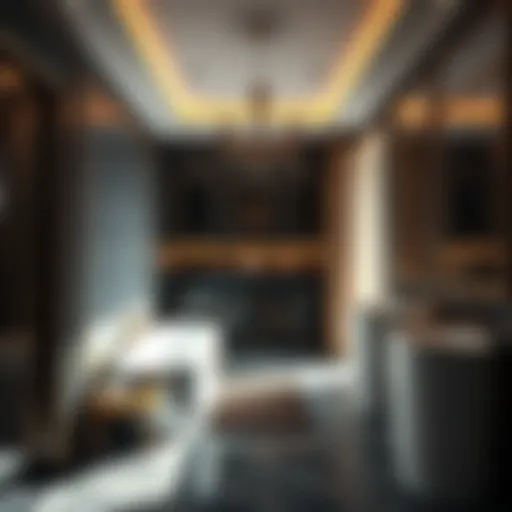Temporary Bathroom Tile Options: Design Impact Revealed
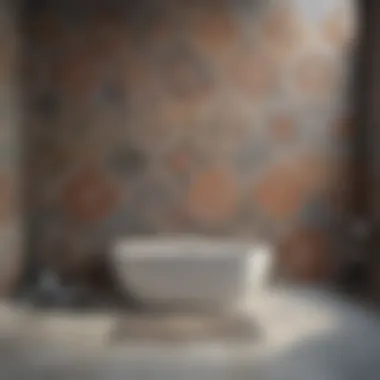

Intro
In the ever-evolving realm of home design, the bathroom stands as a vital oasis, often reflecting personal style alongside functionality. With space becoming a premium in modern living, decor elements such as tiles are pivotal — not only in their aesthetic appeal but also in usability. Temporary bathroom tiles present a compelling option for those who wish to refresh their space without committing to long-term solutions. While homeowners may recoil at the thought of upheaval, exploring different tile varieties can bring about surprising enhancements and renew lifestyle conveniences.
Temporary tiles come to the rescue for renters, or simply those who change their decor like the wind. This article sheds light on a plethora of options available in the market, guiding decisions that may very well reinvigorate one's bathroom ambiance. It is about making choices that resonate with style and reflect individual lifestyle without losing sleep over permanence or extensive labor.
Trending Styles
When it comes to selecting temporary bathroom tiles, style is of utmost importance. Homeowners and designers alike often gravitate towards two dominant trends: Modern Minimalism and Cozy Rustic. Each lends its unique flavor to space, reflecting the personal taste of the dweller.
Modern Minimalism
The modern minimalist approach emphasizes simplicity and clean lines. Tiles that embody this style typically incorporate neutral shades, smooth finishes, and geometric patterns. Think grey ceramic squares or large glossy white panels. These tiles often create an illusion of space, making smaller bathrooms feel airier and more refined. Installing large-format tiles also reduces grout lines, resulting in a sleeker appearance.
An increasing favorite among those going minimalist is the use of peel-and-stick tiles, which can transform a bathroom from drab to fab in mere hours. The ease of installation and replacement makes them ideal for anyone aiming for a chic, contemporary look.
Cozy Rustic
On the flip side, the cozy rustic style invites warmth into bathroom spaces. This feel can be achieved via tiles that mimic natural materials like wood or stone. A common choice is subway tiles with a distressed finish, giving a nod to vintage vibes. Eathy browns and deep greens balance a clean aesthetic while keeping the cozy atmosphere brewing.
The rustic style also allows for creative combinations. For instance, colorful mosaic tiles can create stunning accents, drawing the eye without overwhelming the senses. They can play well with warm lighting, thereby enhancing the inviting feel of a space.
Color Palettes
Color plays a crucial role in setting the mood within any bathroom. When selecting tiles, consider doing so with a keen eye on the color palettes that suit your desired aesthetic. Two popular themes emerge: Calming Neutrals and Bold Accents.
Calming Neutrals
Neutrals such as beige, soft grey, and crisp white provide an instant sense of tranquility. These hues allow for an open and spacious feel. When paired with appropriate lighting and accessories, a neutral palette can create an elegant yet serene environment that participates in the overall ambiance without overpowering it.
For those inclined towards a minimalist design, calm colors work hand in hand. For instance, pairing light grey tiles with matte black fixtures offers a subtle, sophisticated contrast that exudes confidence without being overly flashy.
Bold Accents
Contrarily, bold colors such as deep blues, vibrant reds, or even soothing greens can infuse personality into a bathroom. Accented tiles can serve as focal points that express individuality while harmonizing with surrounding textures. One could opt for a brightly patterned backsplash running along the wash area, effectively making a statement and drawing a visitor's focus.
Understanding Temporary Bathroom Tiles
When it comes to designing or updating a bathroom, the choices we make can ripple out far beyond mere aesthetics. Temporary bathroom tiles capture this duality brilliantly — they offer both flexibility in design and a practical solution for spaces that may need to adapt over time. Understanding these surfaces allows homeowners, renters, and design enthusiasts to navigate the sometimes rough waters of renovation with confidence.
Temporary tiles aren't just a quick fix; they represent a broader shift in how we think about flooring in spaces that can be challenging. From urban apartments to family homes, these options can elevate a bathroom's look without the burden of a permanent installation. Particularly for those who may be living in rented properties or simply prefer a non-committal approach to home design, these tiles open up a world of possibilities.
Definition and Purpose
Temporary bathroom tiles encompass a range of flooring solutions designed for easy installation and removal. Unlike traditional ceramic or stone tiles, which require adhesives and extensive labor, many temporary options use backing methods such as peel-and-stick or interlocking designs. This makes them a popular choice for folks who wish to refresh their space without committing to a long-term, intensive renovation.
The primary purpose of temporary tiles is to provide an affordable, versatile way to enhance functionality while still keeping style in check. They allow for personalization without overwhelming financial and time commitments. Whether you want to swap out a tired design every season or need a quick bathroom upgrade for an upcoming event, temporary tiles offer a pragmatic solution.
Imagine being able to revamp your bathroom in a weekend, shifting from dull to dazzling without shedding blood, sweat, and tears. That’s the kind of flexibility that temporary tiles bring.
Historical Context of Temporary Tiles
Temporary bathroom tiles have roots that stretch back through history, revealing a fascinating evolution in the way we manage interior spaces. While tiling has been a hallmark of bathroom design for centuries, the contemporary concept of temporary options gained traction in the 20th century, particularly during periods of economic fluctuation.
In the post-war era, people began to look for affordable home improvement options, leading to the rise of less permanent materials. With more people renting, there was a growing need for solutions that didn’t entrap the tenant or owner in a long-term commitment. By the 1980s and 1990s, innovations in material technology introduced vinyl and peel-and-stick tiles, making them exceedingly popular in DIY communities.
Fast forward to today, and these materials have become not only practical but stylish as well. From vibrant colors to intricate patterns, today's temporary tiles can align aesthetics with function in ways that their forebears could only dream of.
This historical context is essential for understanding why temporary bathroom tiles hold such value in contemporary design. They reflect changing lifestyles and reveal a broader trend toward flexibility and personalization in home spaces.
Temporary tiles capture our need for adaptability in living spaces, allowing us to express our evolving tastes without sacrificing permanence.
Types of Temporary Bathroom Tiles
The world of bathroom design is not just about tiles of permanent commitment; it also embraces a range of temporary options that allow homeowners a refreshing change without the hassle of long-term installations. Understanding types of temporary bathroom tiles can significantly impact various aspects of space design. Whether one seeks a quick update, a temporary solution for renters, or simply exploring new aesthetics, these tiles provide versatility that resonates well with diverse needs. Each type brings unique benefits and considerations, making it essential for you to know the ins and outs before making your selection.
Vinyl Tiles
Vinyl tiles stand tall in the realm of temporary bathroom solutions, primarily due to their durability and ease of installation. Available in sheets or blocks, vinyl tiles are like a chameleon, easily mimicking the appearance of other materials such as wood or stone. They are water-resistant, making them an excellent choice for bathrooms where moisture can wreak havoc.
When it comes to installation, most vinyl tiles can be laid down without professional assistance. You can simply peel off a backing, stick it on a clean surface, and voilà! However, keep in mind that the quality of the surface underneath can affect the longevity of the tiles. So, a bit of prep work goes a long way!
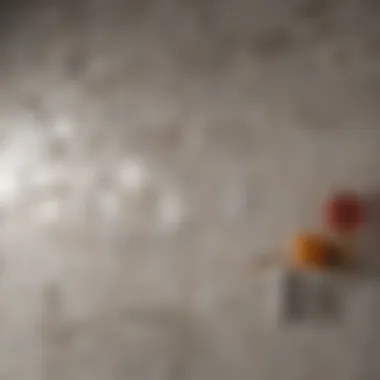

Peel-and-Stick Tiles
Peel-and-stick tiles are the modern DIYer’s best friend. The convenience of this type is hard to match; it’s as simple as peeling off the backing and pressing it onto the desired surface. What’s more, they come in an extensive range of designs, allowing a homeowner to jazz up their bathroom with minimal effort.
One major plus is the affordability. Generally speaking, peel-and-stick tiles don’t break the bank and can serve as a stylish solution for those on a budget. But proceed with caution! If you neglect the right cleaning or the surface preparation, these tiles might not adhere as effectively, resulting in an unseemly appearance.
Rubber Tiles
In recent years, rubber tiles have stepped into the spotlight, and it's easy to see why. Durable and resilient, they’re particularly beneficial in households with kids or the elderly, offering slip resistance that adds a layer of safety. Moreover, rubber is inherently water-resistant, making it suitable for the often damp environment of a bathroom.
While predominantly found in commercial spaces, they are becoming a favorite among design-conscious homeowners looking for a unique touch. However, some may find the appearance less stylish than other materials. Depending on the color and finish, rubber tiles can appear more functional than decorative.
Carpet Tiles
A surprising addition to the bathroom tile world, carpet tiles can offer a cozy, warm touch, especially in colder climates. They provide a softer feel underfoot, perfect for those chilly mornings. They often come in modular formats, making them easy to install and replace.
However, one must consider the practicalities. Carpet tiles tend to absorb moisture, which can lead to mold or mildew if not carefully maintained. So, using them in the bathroom requires diligent upkeep and possibly employing effective moisture control measures.
Interlocking Tiles
Interlocking tiles are a fun, flexible answer for those who like to play with design. These tiles fit together like a puzzle, making installation straightforward. Often made from materials like PVC or foam, they provide easy maintenance and a cushioned flooring option.
A point worth noting is their versatility; you can mix and match colors and designs to create unique patterns tailored to your taste. Yet, depending on the specific material, they may not always hold up well in high-moisture environments, which is crucial to keep in mind when considering their use in bathroom settings.
Material Considerations
When it comes to selecting temporary bathroom tiles, it's vital to consider the various materials available. These choices not only influence the aesthetic appeal of the space but also its longevity and functionality. Understanding the specific characteristics of tile materials can lead you to make a well-informed decision that suits both your taste and your practical needs.
Durability and Resistance
Durability in bathroom tiles is non-negotiable since bathrooms face constant exposure to moisture, high foot traffic, and scuffing. Take vinyl tiles for instance; they are well-known for being resistant to certain impacts and scrapes. This resilience is crucial in a family bathroom where kids might be running in and out. On the other hand, ceramic tiles, while positioned more in the permanent category, can serve as a temporary solution. They resist staining and offer a robust option.
However, not all materials are created equal. Some might look appealing at first glance but will wear down more quickly, demanding replacement sooner than expected.
"The right choice in material can make or break your bathroom experience. A quick fix shouldn't feel like a burden once installed."
Moisture Management
Bathrooms are notoriously humid environments. Hence, effective moisture management becomes a top priority. Tiles made from materials like rubber or vinyl have an inherent advantage due to their non-porous nature. This means they won’t absorb water at the rate that, say, carpet tiles or even certain types of peel-and-stick tiles might. Carpet tiles may seem cozy, but they're susceptible to mold and mildew, creating headaches down the line.
Choosing right materials doesn’t just prevent issues; it extends the life of your bathroom decor and saves money in the long run.
Environmental Impact
With growing awareness about sustainability, one cannot overlook the environmental impact of tile materials. Opting for tiles made from recycled materials or those that feature eco-friendly production processes can have a positive influence on our planet. For example, many manufacturers have started utilizing repurposed vinyl and natural rubber, both of which minimize waste.
Additionally, the longevity of the materials plays a role here. More durable options tend to require less frequent replacement, which can lower waste over time.
So, whether you’re an eco-warrior or someone who simply wants to make smarter choices, be mindful of what you pick. Remember:
- Durable tiles can save costs and reduce waste.
- Eco-friendly options can contribute to a healthier home environment.
- Knowing the impact of your choices fosters informed decisions.
Having a deeper grasp of material considerations in temporary bathroom tiles aids in painting a clearer picture of how your selections can influence not just design but also sustainability and practicality.
Installation Process
The installation process of temporary bathroom tiles serves as a critical phase in ensuring not only the beautification of a space but also its functionality and longevity. Understanding how to incorrectly carry out these steps can lead to unsatisfactory results and unnecessary expenses. Homeowners and renters alike can benefit from mastery of this process, allowing them to transform their bathrooms into attractive retreats without the woes of long-term commitments.
Preparation of the Bathroom Surface
Before any tiles make their way onto the floor or walls, it's crucial to prepare the surface properly. Neglecting this phase can result in everything from uneven surfaces to tiles that simply won't stick. Think about it like the foundation of a house; if it's shaky, problems will come knocking.
Steps to prepare the bathroom surface include:
- Cleaning: Remove dirt, grime, and any existing adhesive. A simple soap-and-water solution often does wonders.
- Drying: Ensure the surface is completely dry; moisture can wreak havoc on your adhesive.
- Smoothing: Fill in any uneven spots with a cement-based compound, which provides a strong foundation for the tiles.
Even slight imperfections can lead to tiles shifting over time, so getting the surface right is worth the elbow grease.
Step-by-Step Installation Guide
Successfully installing temporary tiles doesn't have to be a monumental task. With the right approach, it can be straightforward and rewarding. Here’s a practical guide to set you on the right path:
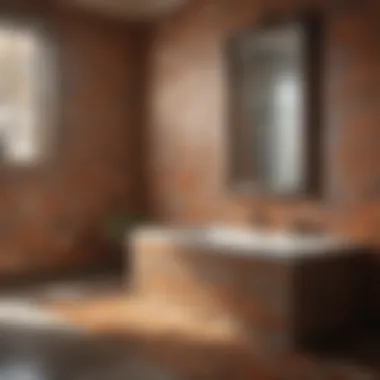

- Gather Materials: Tiles, adhesive, tools like a knife, and a measuring tape are necessities.
- Measure the Area: Always measure twice; cutting once isn’t enough when mistakes can happen.
- Plan Your Layout: Start from the center or a corner, depending on your design vision. Visualizing where each tile will go before you start can save headaches later.
- Apply Adhesive: Follow the manufacturer’s instructions to apply adhesive. Don’t be shy; spread just enough to cover the area before you lay down tiles.
- Lay Tiles: Place each tile firmly onto the adhesive and press down. For peel-and-stick, simply peel off the backing and stick.
- Cut Tiles as Needed: Use a sharp knife to trim tiles around edges and fixtures.
- Final Touches: If necessary, apply grout or sealant. Finally, step back and admire your handiwork.
This kind of systematic approach reduces the chance for error and keeps the project seamless.
Common Installation Pitfalls
Even the best-laid plans can have hurdles. Being aware of common mistakes can prevent frustration:
- Inadequate Surface Prep: Forgetting to clean or dry surfaces can lead to poor adhesion.
- Ignoring Climate Considerations: Extreme temperature fluctuations can impact adhesives and tile behavior.
- Overzealous Adhesive Application: Using too much adhesive can lead to ooze and uneven surfaces.
- Not Allowing for Expansion: Tiles can expand and contract. Leaving tiny gaps in between tiles allows this natural movement.
"Mistakes often provide the best lessons. Recognizing potential snafus can save both time and money."
By understanding the installation process thoroughly, homeowners can better equip themselves to tackle these projects, leading to successful transformations in their bathrooms. Engaging with this hands-on task not only nurtures a sense of accomplishment but also empowers individuals to take charge of their living spaces.
Maintenance of Temporary Tiles
Maintaining temporary bathroom tiles is crucial for ensuring they last and continue to look appealing over time. While the beauty of these tiles lies in their ease of installation and flexibility, their upkeep is no less important. Regular maintenance not only helps keep your bathroom space refreshing but also extends the life of the tiles, ultimately saving you time and money.
Cleaning Techniques
Cleaning temporary tiles doesn't need to be a daunting task if approached with the right techniques. Here are some effective methods for different tile types:
- Vinyl Tiles: For vinyl, a simple solution of warm water and mild detergent usually does the trick. Using a soft cloth or mop, wipe down the tiles and let them air dry. Avoid harsh chemicals as they can degrade the surface over time.
- Peel-and-Stick Tiles: These tiles require a bit more care. A damp microfiber cloth is best for them. It's wise to avoid soaking them; moisture can lift the edges. In case of sticky residues, a bit of vinegar mixed with water can help dissolve those pesky marks.
- Rubber Tiles: Showering with rubber tiles can lead to mold and mildew. Regularly scrub them with a gentle brush and a mix of soap and water will keep them clean. Be sure to rinse well to avoid soap buildup.
- Interlocking Tiles: Since these tiles are often in high-traffic areas, vacuuming or sweeping them routinely is recommended. To clean deeper, using a steam cleaner can be beneficial. Just ensure you do not leave standing water as it can cause warping or slipping.
"Regular cleaning not only maintains aesthetics but also promotes hygiene in a space often damp and humid."
Repair and Replacement Options
Inevitably, wear and tear might necessitate repair or replacement of some tiles. The good news? Many temporary tile options come with a DIY-friendly approach to fixes.
- Repair: Small damages like scratches on vinyl tiles can often be waved goodbye with a bit of heat. Using a hairdryer can soften the tile, allowing you to gently reshape it. For surface blemishes, try using a colored marker or a specialized repair kit designed for vinyl.
- Replacement: When it comes to replacing, the ease of doing so differs among tile types. Peel-and-stick tiles often allow you to remove the damaged piece and adhere a new one without fuss. Rubber tiles, however, might require a complete removal since they are usually glued down. It is vital to always keep a few extra tiles on hand, especially in cases where patterns or colors may be discontinued.
In summary, taking time to maintain your temporary tiles through simple cleaning and repair methods can keep your bathroom looking sharp and stylish. A little attention goes a long way, ensuring that your investments continue to serve you well.
Aesthetic Integration in Bathroom Design
When it comes to bathroom design, aesthetics play a key role in creating a space that feels inviting and functional. This is particularly true when utilizing temporary bathroom tiles, as they can dramatically influence the overall ambiance of the room. The goal here is not just to make the bathroom look good, but to construct a cohesive environment that integrates well with the existing elements. The right selection of colors, patterns, and textures can transform a mundane bathroom into a stylish retreat.
Color Schemes and Patterns
Color schemes and patterns are paramount in achieving visual harmony in a bathroom. Choosing the right palette can echo personal style while also setting the mood.
- Neutral Tones: Opting for shades like beige, gray, or soft white offers a calm, spacious feel and pairs well with various fixtures.
- Bold Colors: If you want to make a statement, consider rich blues or vibrant greens. These hues energize the space and, when combined with the right patterns, can create a stunning focal point.
- Patterns:
- Geometric tiles add a modern edge.
- Floral designs might lend a vintage touch. Adding texture can amplify the impact even further. Textured tiles not only enhance the visual appeal but also add depth to the space, compelling visitors to explore.
Things to keep in mind: Coordinate the tile colors with wall paint and furniture for a seamless look.
"Color is the keyboard, the eyes are the harmonies, the soul is the piano with many strings." - Wassily Kandinsky
Coordinating with Fixtures and Accessories
To truly master aesthetic integration, it’s crucial to consider how tiles work with other elements in the bathroom. Here’s how we can think about this:
- Fixture Selection: Sink, toilet, and bathtub finishes should complement the tile choice. For instance, sleek chrome fixtures pair well with modern tiles, while brushed gold might look fantastic alongside warmer tiles.
- Accessories: Accessories such as towels, soap dishes, and rugs often serve as the icing on the cake. Selecting these items to echo or contrast the tile design can provide a layer of complexity to the space. For example, pairing pastel tiles with bold-hued towels creates a fresh and inviting look.
- Natural Elements: Incorporating plants can soften the often sterile look of tiles, bringing in a touch of nature that adds to the overall warmth and livability.
Cost Analysis and Budgeting
When it comes to renovating or upgrading a bathroom, understanding the financial implications is crucial. Cost analysis and budgeting for temporary bathroom tile options not only affects your wallet but also influences your design decisions. These tiles present a practical solution for those looking to refresh their space without committing to a permanent change.
Comparison of Temporary vs. Permanent Tiles
The first step in budget analysis is understanding the cost distinctions between temporary and permanent tiles. Temporary tiles, such as vinyl, peel-and-stick, and even rubber options, usually come with a lower price tag both in materials and installation costs when compared to traditional ceramic or porcelain tiles.
- Material Costs: Temporary tiles can often be found at a fraction of the price of their permanent counterparts. For instance, a box of adhesive vinyl tiles might cost around twenty-five bucks, while high-end ceramic tiles could easily exceed one hundred dollars per box.
- Installation Costs: Installation of temporary tiles is typically straightforward. Many homeowners choose to install these products themselves, thus saving on labor costs. Permanent tiles, contrarily, might require professional installation due to the more intricate processes involved, which can inflate costs significantly.
- Longevity and Replacement: While temporary tiles come with a shortened lifespan—lasting from a few years to a decade depending on wear—the flexibility they offer means less risk if your design preferences change. You can easily replace them without breaking the bank. Permanent tiles provide durability but at a higher cost, making them less ideal for those who like to change their decor often.
"Opting for temporary over permanent tiles can free up budget for other upgrades, like new fixtures or lighting."
Budgeting for Installation
When budgeting specifically for installation, various factors should be considered. Here’s what to keep in mind:
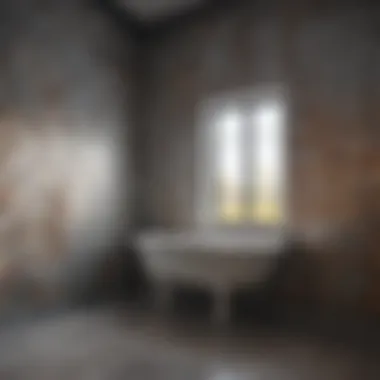

- Surface Preparation: Before laying down new tiles, the existing surface may require patching or leveling. This can incur additional costs, especially if materials are needed.
- Tools and Supplies: If you're installing tiles yourself, you'll likely need special tools or supplies, such as tile cutters or adhesive. Consider these additional costs in your budget.
- Potential Hidden Costs: Always keep some reserve funds for unexpected issues that may arise during installation. Uneven surfaces or old adhesives can add to your expenses.
To break these aspects down:
- Temporary Tile Materials: Determine cost per square foot for each tile type.
- DIY vs. Professional Installation: Calculate the difference in costs and see what fits your time and budget.
- Initial Budget Plan: List out expected costs upfront, considering both materials and potential hidden expenses.
Ultimately, engaging in a thorough cost analysis and thoughtful budgeting can make a huge difference in your bathroom design journey. It not only helps keep finances in check but also allows for greater flexibility in choosing both temporary and lasting solutions.
When to Choose Temporary Over Permanent
In the realm of bathroom design, navigating the intricate balancing act between style, functionality, and permanence can feel like a game of chess. The decision to invest in temporary tiles rather than permanent solutions hinges on a variety of factors that range from practical considerations to personal preferences. It’s essential to understand the scenarios where temporary tiles shine brighter than their more permanent counterparts, especially for homeowners looking to refresh their space without a deep financial or emotional commitment.
Situations Favoring Temporary Solutions
Temporary bathroom tiles can often come to the rescue in various situations where flexibility and adaptability are paramount. Here are some contexts where choosing temporary solutions makes sense:
- Rental Properties: Renters often want to inject a bit of personality into their spaces without risking their security deposit. Temporary tiles, like peel-and-stick options, offer an easy and removable way to enhance a bathroom without the fallout of permanent alterations.
- Fast Turnaround Projects: If you’re sprucing up a space for a quick sale or an upcoming event, temporary tiles can be a timesaver. With a few hours of easy installation, your bathroom can get a facelift that feels fresh and inviting.
- Lifestyle Changes: As family dynamics shift—like welcoming kids or accommodating aging parents—adapting your space with temporary options allows for quicker adjustments. For instance, rubber tiles in wet areas can provide a safe bathing experience for little ones.
- Seasonal Updates: Some homeowners enjoy changing their aesthetic regularly, much like changing wardrobe with the seasons. Temporary tiles let you revamp your bathroom vibe, from bright colors in summer to warmer tones in winter, without much hassle.
In these cases and beyond, temporary tiles are a pragmatic choice, allowing versatility that suits modern living.
Long-Term vs. Short-Term Needs
When weighing the decision between temporary and permanent options, it’s crucial to think about your immediate and future needs. How long do you envision the space meeting certain designs or styles? Here’s a breakdown to consider:
- Short-Term Needs: If your priorities shift frequently or if you’re in a transient phase of life—like a student or young professional—temporary tiles provide a perfect fit. They are inexpensive, easy to install, and equally simple to remove when you’re ready for the next chapter.
- Long-Term Vision: Conversely, if you’re planning to settle down in your home for the foreseeable future, investing in permanent tiles may ultimately be worth it. Permanent tiles can offer superior durability and a timeless aesthetic. However, if circumstances change—like selling your home or moving—temporary solutions can still serve a purpose during an interim phase.
In assessing your situation, consider how long you intend to remain in your current living environment, coupled with your design aspirations. Making an informed choice will not only make your bathroom look inviting but also reflect your lifestyle.
"Temporary tiles can provide functionality and flair without the weight of commitment, making them a practical choice for many homeowners today."
Ultimately, whether to choose temporary or permanent tiles boils down to personal circumstances. Weighing out the benefits, personal whims, and lifestyle needs can guide you toward the right investment for your bathroom space.
Innovations in Temporary Bathroom Tile Technology
Innovation is the name of the game in the world of temporary bathroom tiles. As design trends evolve and consumer needs shift, the tile industry has been quick to adapt. Today's temporary tiles are not just about functionality; they also embrace aesthetics and sustainability. Understanding these innovations helps homeowners and renters make decisions that suit their living spaces and lifestyles.
Advancements in Material Technology
Recent advancements in material technology have revolutionized the options available for temporary bathroom tiles. For starters, manufacturers are now utilizing high-quality vinyl and composite materials, which boast improved durability and resistance to moisture. This means homeowners can install tiles that not only look appealing but can also withstand the rigors of a wet environment.
- Vinyl with enhanced properties: These modern vinyl tiles are designed with extra cushioning and anti-slip textures, increasing safety while providing comfort underfoot. They're also often thicker, giving them a more substantial feel when laid down.
- Eco-friendly materials: With sustainability on many people's minds, several companies are developing tiles made from recycled and renewable materials. This minimizes the environmental footprint while catering to eco-conscious consumers.
This amalgamation of aesthetics and functional innovation reflects a broader trend in home design, where form goes hand-in-hand with function. Moreover, with processes like digital printing, manufacturers can offer a wide variety of designs and patterns that can mimic natural materials such as wood or stone, providing a chic look without the associated upkeep.
Trends in Design and Functionality
When it comes to design and functionality, the latest trends showcase versatility and user-centric solutions. Color and pattern variety have significantly expanded, allowing homeowners to express their personal style through temporary tiles. Gone are the days of plain, one-dimensional tiles. Instead,
- Bold Patterns: From geometric designs to more intricate florals, temporary tiles are now available with striking aesthetics that can truly transform a space.
- Customizability: Many tiles now come in modular designs that not only ease installation but also encourage creative patterns and arrangements that might not have been feasible with traditional tiling methods.
These innovations bring an added layer of functionality. For instance, several tiles are now designed to be easily removable, allowing for quick updates according to seasonal trends or personal preferences. Householders can change their bathroom's look as easily as they swap out a shower curtain.
"Temporary tiles have come a long way from their humble origins. The intersection of innovation and user demand has created a space where aesthetics meet practicality."
With innovations continually emerging, it's worth keeping an eye on new materials and designs as they hit the market. Being informed empowers homeowners and renters to make savvy choices that can breathe fresh life into their bathrooms without breaking the bank or making permanent commitments.
Finale and Future Perspectives
As we wrap up our exploration of temporary bathroom tile options, it’s essential to reflect on both their impact on space design and the benefits they confer to homeowners and renters alike. The beauty of temporary tiles lies not just in their flexibility but also in their ability to transform spaces quickly and affordably. They are a practical choice for those who might be considering a short-term stay or want to experiment with aesthetics without the commitment of permanent installations.
Final Thoughts on Temporary Bathroom Tiles
In summary, temporary bathroom tiles are gaining traction for various reasons. They offer versatility, allowing you to change the look of your bathroom without the hassles tied to traditional tiles. One can easily find a range of styles and colors, catering to different aesthetics—whether you're going for a sleek modern look or a vibrant retro feel. Moreover, installations can be completed with minimal tools, making it a feasible weekend project for anyone who fancies a bit of DIY.
Temporary tiles can be a savvy, stylish solution for any bathroom refresh, marrying form and function effortlessly.
However, not all temporary tiles are created equal. It's crucial to pick materials that are moisture resistant and durable to prevent any mishaps in a high-humidity environment. Regular maintenance is required, but the cleaning methods are straightforward, often involving a simple damp mop or occasional deep cleaning depending on the material used.
Emerging Trends to Watch
Looking ahead, the realm of temporary bathroom tiles is bound to see exciting innovations. One prominent trend is the rise of sustainable materials—more brands are now offering tiles made from recycled products or sustainable sources, appealing to environmentally conscious homeowners. Also, technological advancements in the production of vinyl and peel-and-stick tiles have enhanced their resilience, making them even more suitable for wet environments.
In terms of design, we’re witnessing a shift toward bold patterns and colors. Homeowners are becoming bolder in their choices, opting for eye-catching designs that can serve as focal points in bathroom décor. Mixing different styles and patterns for a personalized touch is also becoming increasingly popular.
Furthermore, interactive digital platforms for design inspiration are evolving. From applications that allow you to visualize tiles in your space before committing to a purchase, to online communities where homeowners share tips and ideas—these resources offer invaluable insights for anyone considering temporary tiles.
As homeowners continue to embrace flexibility in design, the future of temporary bathroom tiles appears bright. They will not only serve as functional flooring solutions but also as a canvas for personal expression, craftsmanship, and sustainability.
In a nutshell, temporary bathroom tiles make it practical and achievable to personalize a bathroom, be it for a quick makeover or between more permanent renovations.













